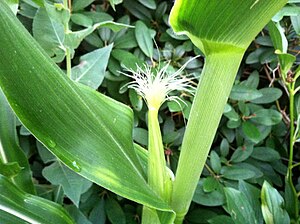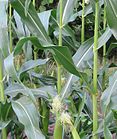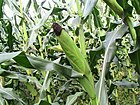Note: This is a project under development. The articles on this wiki are just being initiated and broadly incomplete. You can Help creating new pages.
Zea mays
Zea mays is an erect, robust, usually unbranched annual plant. It can grow up to 6 metres tall but is more likely to around 2 metres with cultivars that can range from around 1 metre up to 3 metres or more. Maize is one of the most commonly cultivated crops in the world, providing a range of foods including popcorn, sweetcorn and a grain that can be ground into a flour.
Contents
[hide]- 1 Uses
- 2 Parts Used
- 3 Chemical Composition
- 4 Common names
- 5 Properties
- 6 Habit
- 7 Identification
- 8 List of Ayurvedic medicine in which the herb is used
- 9 Where to get the saplings
- 10 Mode of Propagation
- 11 How to plant/cultivate
- 12 Commonly seen growing in areas
- 13 Photo Gallery
- 14 References
- 15 External Links
Uses
Strangury, Dysuria, Diabetes, Gonorrhoea, Gout, Cystitis, Nose bleeds, Menorrhagia, Ulcers, Swellings, Rheumatic pains.[1]
Parts Used
Chemical Composition
Chemical constituents of corn grains are total P mg/g, total N mg/g, crude protein %, carbohydrate %, T.S.S. %, starch % and oil etc.[3]
Common names
| Language | Common name |
|---|---|
| Kannada | Govina Jola, Mekke Jola |
| Hindi | Maakai |
| Malayalam | Jolam |
| Tamil | Makka Jolam |
| Telugu | Mokka Jonna |
| Marathi | |
| Gujarathi | |
| Punjabi | |
| Kashmiri | |
| Sanskrit | Yavanala |
| English | Mej |
Properties
Reference: Dravya - Substance, Rasa - Taste, Guna - Qualities, Veerya - Potency, Vipaka - Post-digesion effect, Karma - Pharmacological activity, Prabhava - Therepeutics.
Dravya
Rasa
Guna
Veerya
Vipaka
Karma
Prabhava
Habit
Identification
Leaf
| Kind | Shape | Feature |
|---|---|---|
Flower
| Type | Size | Color and composition | Stamen | More information |
|---|---|---|---|---|
| Flowering season is August - November |
Fruit
| Type | Size | Mass | Appearance | Seeds | More information |
|---|---|---|---|---|---|
| Fruiting season is August - November |
Other features
List of Ayurvedic medicine in which the herb is used
Where to get the saplings
Mode of Propagation
How to plant/cultivate
Plants grow well in lowland tropical areas and can succeed at elevations up to 2,000 metres.[5]
Commonly seen growing in areas
[[:Category:Herbs that are commonly seen in the region of |]], [[:Category:Herbs that are commonly seen in the region of |]], [[:Category:Herbs that are commonly seen in the region of |]], [[:Category:Herbs that are commonly seen in the region of |]], [[:Category:Herbs that are commonly seen in the region of |]].
Photo Gallery
References
- Jump up ↑ Indian Medicinal Plants by C.P.Khare
- ↑ Jump up to: 2.0 2.1 "Karnataka Medicinal Plants Volume - 2" by Dr.M. R. Gurudeva, Page No.571, Published by Divyachandra Prakashana, #45, Paapannana Tota, 1st Main road, Basaveshwara Nagara, Bengaluru.
- Jump up ↑ Chemical constituents
- Jump up ↑ [Morphology]
- Jump up ↑ Cultivation
External Links
- Ayurvedic Herbs known to be helpful to treat Strangury
- Ayurvedic Herbs known to be helpful to treat Dysuria
- Ayurvedic Herbs known to be helpful to treat Diabetes
- Ayurvedic Herbs known to be helpful to treat Gonorrhoea
- Ayurvedic Herbs known to be helpful to treat Gout
- Ayurvedic Herbs known to be helpful to treat Cystitis
- Ayurvedic Herbs known to be helpful to treat Nose bleeds
- Ayurvedic Herbs known to be helpful to treat Menorrhagia
- Ayurvedic Herbs known to be helpful to treat Ulcers
- Ayurvedic Herbs known to be helpful to treat Swellings
- Ayurvedic Herbs known to be helpful to treat Rheumatic pains
- Herbs with A grain of corn used in medicine
- Herbs with common name in Kannada
- Herbs with common name in Hindi
- Herbs with common name in Malayalam
- Herbs with common name in Tamil
- Herbs with common name in Telugu
- Herbs with common name in Sanskrit
- Herbs with common name in English
- Habit - Annual
- Index of Plants which can be propagated by Seeds
- Herbs that are commonly seen in the region of
- Herbs







